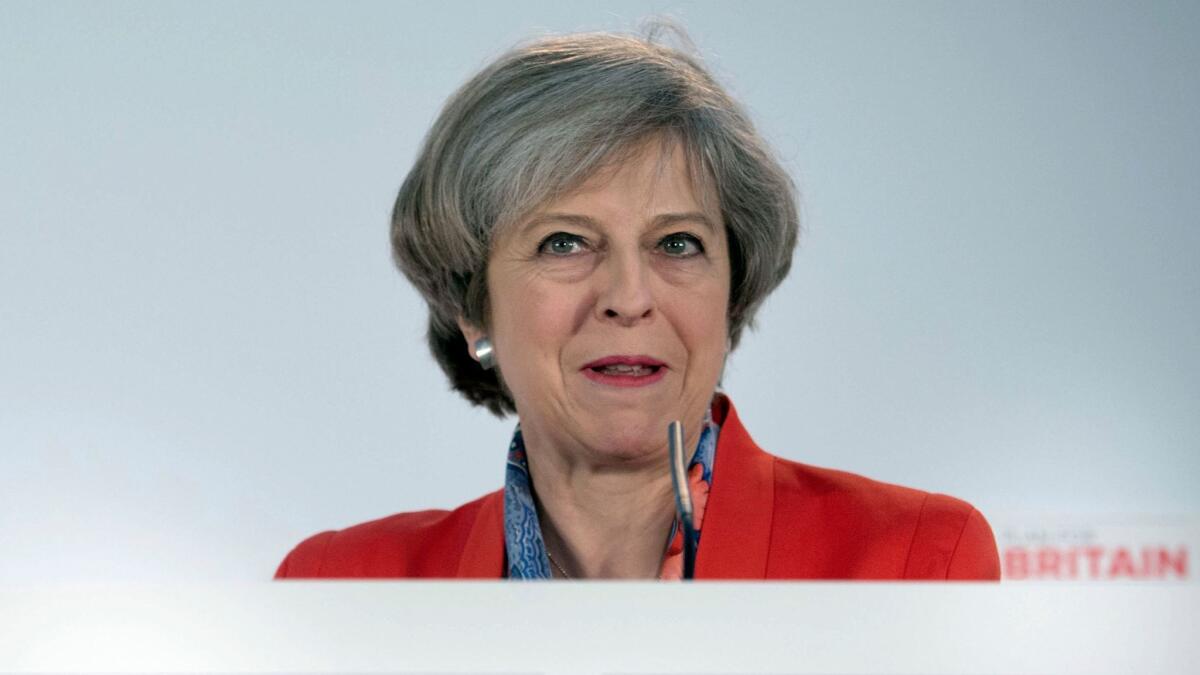A letter from Britain to the European Union will trigger the ‘Brexit’ process March 29

Reporting from London — A letter is expected to land on the desk of European Council President Donald Tusk next week that will signal the start of the fundamental reshaping of Britain and Europe.
The document, carrying the signature of British Prime Minister Theresa May, will provide formal notice that Britain is withdrawing from the 28-nation European Union after more than 40 years of membership.
For the record:
9:50 a.m. Nov. 16, 2024An earlier version of this article identified the Liberal Democratic leader as Tim Fallon. He is Tim Farron.
British officials said Monday that the expected two-year period of negotiations for leaving the bloc will begin when the letter is delivered March 29, triggering Article 50 of the Lisbon Treaty — the formal process for the withdrawal.
The country must work out numerous issues with the remaining 27 EU nations, including trade and immigration deals, workers’ rights and the conditions for retirees and students to live and study abroad.
“We are on the threshold of the most important negotiation for this country for a generation,” David Davis, secretary of state for exiting the European Union, said in a statement.
“The government is clear in its aims: a deal that works for every nation and region of the U.K. and indeed for all of Europe — a new, positive partnership between the U.K. and our friends and allies in the European Union,” he said.
May, during a speech in Wales on Monday, stressed that she was committed to securing the right deal for Britain as part of what is commonly known as Brexit. She said the June referendum in which voters favored leaving the European Union 52% to 48% was not just about exiting from the EU, but a vote for a “change in the way the country works.”
Exactly how May, leader of the Conservative Party, and her government plan to secure that change remains far from clear and, in the short term, Britain is likely to be thrown into a period of intense uncertainty.
The Labor Party’s Brexit secretary Keir Starmer painted an ominous picture of the road ahead, saying, “Britain is now more divided at home and isolated abroad.”
He also criticized the prime minister for failing to provide greater certainty about what Brexit would look like, or making sure a contingency plan was in place in case no deal was reached within the two-year negotiation period.
Liberal Democrat leader Tim Farron said the prime minister “rushed this through without a plan, and without a clue.”
The developments have also stirred differences of opinion within the components of the United Kingdom — England, Northern Ireland, Scotland and Wales.
Scottish First Minister Nicola Sturgeon has called for a second independence referendum within two years, once the full terms of the Brexit deal are known.
May has rejected such an idea, saying “now is not the time,” but the issue is unlikely to go away considering that Scotland voted 62% to 38% to remain within the EU and feels it is being withdrawn against its will.
May, who succeeded David Cameron after he campaigned for the losing side in the referendum, has said she intended to trigger Article 50 by the end of March.
The timeline was thrown into doubt after a legal challenge was mounted against the government questioning the mandate the prime minister had to take Britain out of the European Union without Parliament’s approval.
The case went all the way to the Supreme Court, which ruled that May needed the backing of both the House of Commons and House of Lords to proceed. Lawmakers last week approved the Brexit Bill — formally called the European Union (Notification of Withdrawal) Act — and it was ratified by Queen Elizabeth II.
May is expected to make a statement to the House of Commons setting out her agenda for the months and years ahead. She has previously said that there could be no “half in, half out” deal and Britain is prepared to withdraw from the European single market — a central tenet of the European Union that guarantees the free movement of goods, capital, services and people — and also the customs union, which guarantees tariff-free trade within Europe.
“No deal for Britain is better than a bad deal for Britain,” May said during a January speech.
For their part, several European officials have said they are poised and ready to get negotiations underway.
“Within 48 hours of the U.K. triggering Article 50, I will present the draft #Brexit guidelines to the EU27 Member States,” Tusk wrote on Twitter on Monday.
Tusk said EU leaders will meet within four to six weeks to decide on their negotiating stance, paving the way for discussions to begin around May. After a draft deal is drawn up, it will need to be approved by at least 20 of the remaining 27 EU member states and ratified by the European Parliament.
May has said she will give lawmakers a vote on the deal she negotiates.
Economics and public policy professor Jonathan Portes of King’s College London said the negotiations probably will result in “a compromise no one likes, but everyone will describe as a victory.”
“But if politics — either here or on the continent — derails the process,” Portes said, “we could soon find that far from ‘taking back control,’ we have done precisely the opposite.”
Boyle is a special correspondent.
ALSO
Far-right populism falters with Dutch vote, but remains a powerful force
Scotland’s leader to seek new independence referendum
Strained U.S.-German ties and Russia in focus as Trump plans first meeting with Merkel
UPDATES:
4:55 p.m.: This article has been updated throughout with Times reporting.
This article was originally published at 5:10 a.m.
More to Read
Sign up for Essential California
The most important California stories and recommendations in your inbox every morning.
You may occasionally receive promotional content from the Los Angeles Times.










